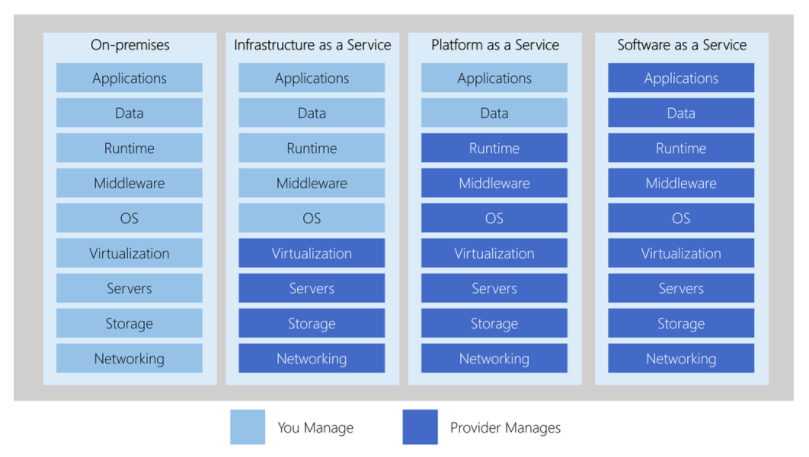Last updated on July 10, 2023
Azure Cloud Service Models Cheat Sheet
- The three cloud computing service models are IaaS, PaaS, and SaaS.
- You can also use serverless computing to eliminate the need to manage infrastructure.
- The shared responsibility model determines the security tasks that are handled by the cloud provider and handled by the customer.
- Azure is responsible for protecting the infrastructure such as hosts, network, and data center.
- The customer is responsible for protecting their data, endpoints, account, and access management.
- IaaS, PaaS, and SaaS have different levels of managed services:
Infrastructure as a service (IaaS)
- Most user management
- You are responsible for managing the operating systems, data, and applications.
- IaaS helps you to extend resources rapidly to meet the spikes required for your application.
- Used in the following scenarios:
- Migrating workloads – move existing applications to the cloud.
- Test and development – quickly set up and dismantle test and development environments. IaaS makes scaling development and testing environments, fast and economical.
- Storage, backup, and recovery – simplify the planning and management of backup and recovery systems.
- Website hosting – less expensive than traditional web hosting.
- High-performance computing (HPC) – clusters of computers that help solve complex problems involving millions of variables or calculations.
- Big data analysis – for massive data sets that require a huge amount of processing power.
Platform as a service (PaaS)
- Less user management
- The operating systems are managed by the cloud provider, while the user is responsible for the applications and data they run and store.
- PaaS offers all the functionality you need to support the entire lifecycle of web applications: building, testing the application, deploying the source code, managing, and updating within the same integrated environment.
- Used in the following scenarios:
- Development framework – a framework for creating or customizing cloud-based applications.
- Analytics or business intelligence – find insights and patterns, and predict outcomes to improve business decisions.
Software as a service (SaaS)
- Least amount of management
- The cloud provider is responsible for managing everything, and the end-user just uses the software.
Serverless Computing
- Function as a Service (FaaS)
- You simply deploy the code with a serverless platform, and it runs at high availability.
- Dynamically scales up and down to meet the demands of each workload within seconds.
- A pay-per-execution model that charges sub-second billing only for the time and resources required to execute the code.
Validate Your Knowledge
Question 1
Question Type: Single choice
In the Azure Shared Responsibility Model, whose responsibility is it to patch the operating system of an Azure App Service?
- Azure
- Customer
- Both Azure and the customer
- Neither Azure nor the customer
For more Azure practice exam questions with detailed explanations, check out the Tutorials Dojo Portal:
Azure Cloud Service Models Cheat Sheet References:
https://docs.microsoft.com/en-us/learn/modules/principles-cloud-computing/5-types-of-cloud-services
https://azure.microsoft.com/en-us/overview/what-is-iaas/
https://azure.microsoft.com/en-us/overview/what-is-paas/
https://azure.microsoft.com/en-us/overview/what-is-saas/
https://azure.microsoft.com/en-us/overview/serverless-computing/





















